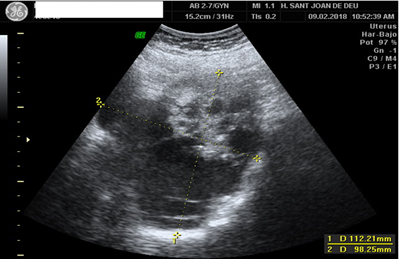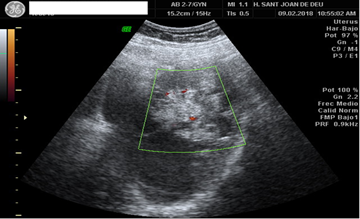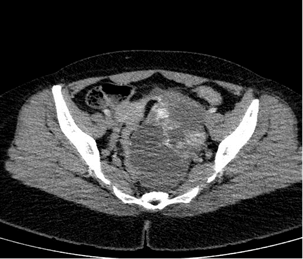Struma Ovarii Mimeting Malignant Ovarian Tumor in Preoperative Examinations
Gonzalez-Bosquet E1*, Jou Munoz C2, Sousa Cacheiro P3
1Department of Obstetrics and Gynecology, Sant Joan de Déu University Hospital, Pg. Sant Joan de Déu, 2 080950 Esplugues (Barcelona), Spain
2Department of Pathology, Sant Joan de Déu University Hospital, Pg. Sant Joan de Déu, 2 080950 Esplugues (Barcelona), Spain
3Department of Radiology, Sant Joan de Déu University Hospital, Pg. Sant Joan de Déu, 2 080950 Esplugues (Barcelona), Spain
*Corresponding Author: Gonzalez-Bosquet E, Department of Obstetrics and Gynecology, Sant Joan de Déu University Hospital, Pg. Sant Joan de Déu, 2 080950 Esplugues (Barcelona), Spain
Received: 22 April 2018; Accepted: 01 June 2018; Published: 04 June 2018
Article Information
Citation:
Gonzalez-Bosquet E, Jou Muñoz C, Sousa Cacheiro P. Struma Ovarii Mimeting Malignant Ovarian Tumor in Preoperative Examinations. Obstetrics and Gynecology Research 1 (2018): 075-079.
View / Download Pdf Share at FacebookAbstract
We present the case of a 39 year-old woman with a possible malignant ovarian tumor suspected in imaging tests. After the laparoscopic surgery removal of the ovary, the definitive histological diagnosis is struma ovarii, a rare benign ovarian tumor. We take the case to discuss different aspects of the diagnosis of this rare tumor and how it can be easily confused with an ovarian cancer.
Keywords
Ovarian Cancer; Laparoscopic Surgery
Ovarian Cancer articles Ovarian Cancer Research articles Ovarian Cancer review articles Ovarian Cancer PubMed articles Ovarian Cancer PubMed Central articles Ovarian Cancer 2023 articles Ovarian Cancer 2024 articles Ovarian Cancer Scopus articles Ovarian Cancer impact factor journals Ovarian Cancer Scopus journals Ovarian Cancer PubMed journals Ovarian Cancer medical journals Ovarian Cancer free journals Ovarian Cancer best journals Ovarian Cancer top journals Ovarian Cancer free medical journals Ovarian Cancer famous journals Ovarian Cancer Google Scholar indexed journals Laparoscopic Surgery articles Laparoscopic Surgery Research articles Laparoscopic Surgery review articles Laparoscopic Surgery PubMed articles Laparoscopic Surgery PubMed Central articles Laparoscopic Surgery 2023 articles Laparoscopic Surgery 2024 articles Laparoscopic Surgery Scopus articles Laparoscopic Surgery impact factor journals Laparoscopic Surgery Scopus journals Laparoscopic Surgery PubMed journals Laparoscopic Surgery medical journals Laparoscopic Surgery free journals Laparoscopic Surgery best journals Laparoscopic Surgery top journals Laparoscopic Surgery free medical journals Laparoscopic Surgery famous journals Laparoscopic Surgery Google Scholar indexed journals Ovarian teratoma tumor articles Ovarian teratoma tumor Research articles Ovarian teratoma tumor review articles Ovarian teratoma tumor PubMed articles Ovarian teratoma tumor PubMed Central articles Ovarian teratoma tumor 2023 articles Ovarian teratoma tumor 2024 articles Ovarian teratoma tumor Scopus articles Ovarian teratoma tumor impact factor journals Ovarian teratoma tumor Scopus journals Ovarian teratoma tumor PubMed journals Ovarian teratoma tumor medical journals Ovarian teratoma tumor free journals Ovarian teratoma tumor best journals Ovarian teratoma tumor top journals Ovarian teratoma tumor free medical journals Ovarian teratoma tumor famous journals Ovarian teratoma tumor Google Scholar indexed journals thyroid articles thyroid Research articles thyroid review articles thyroid PubMed articles thyroid PubMed Central articles thyroid 2023 articles thyroid 2024 articles thyroid Scopus articles thyroid impact factor journals thyroid Scopus journals thyroid PubMed journals thyroid medical journals thyroid free journals thyroid best journals thyroid top journals thyroid free medical journals thyroid famous journals thyroid Google Scholar indexed journals struma ovarii articles struma ovarii Research articles struma ovarii review articles struma ovarii PubMed articles struma ovarii PubMed Central articles struma ovarii 2023 articles struma ovarii 2024 articles struma ovarii Scopus articles struma ovarii impact factor journals struma ovarii Scopus journals struma ovarii PubMed journals struma ovarii medical journals struma ovarii free journals struma ovarii best journals struma ovarii top journals struma ovarii free medical journals struma ovarii famous journals struma ovarii Google Scholar indexed journals neural tumors articles neural tumors Research articles neural tumors review articles neural tumors PubMed articles neural tumors PubMed Central articles neural tumors 2023 articles neural tumors 2024 articles neural tumors Scopus articles neural tumors impact factor journals neural tumors Scopus journals neural tumors PubMed journals neural tumors medical journals neural tumors free journals neural tumors best journals neural tumors top journals neural tumors free medical journals neural tumors famous journals neural tumors Google Scholar indexed journals hyperthyroidism articles hyperthyroidism Research articles hyperthyroidism review articles hyperthyroidism PubMed articles hyperthyroidism PubMed Central articles hyperthyroidism 2023 articles hyperthyroidism 2024 articles hyperthyroidism Scopus articles hyperthyroidism impact factor journals hyperthyroidism Scopus journals hyperthyroidism PubMed journals hyperthyroidism medical journals hyperthyroidism free journals hyperthyroidism best journals hyperthyroidism top journals hyperthyroidism free medical journals hyperthyroidism famous journals hyperthyroidism Google Scholar indexed journals ultrasonography articles ultrasonography Research articles ultrasonography review articles ultrasonography PubMed articles ultrasonography PubMed Central articles ultrasonography 2023 articles ultrasonography 2024 articles ultrasonography Scopus articles ultrasonography impact factor journals ultrasonography Scopus journals ultrasonography PubMed journals ultrasonography medical journals ultrasonography free journals ultrasonography best journals ultrasonography top journals ultrasonography free medical journals ultrasonography famous journals ultrasonography Google Scholar indexed journals abortion articles abortion Research articles abortion review articles abortion PubMed articles abortion PubMed Central articles abortion 2023 articles abortion 2024 articles abortion Scopus articles abortion impact factor journals abortion Scopus journals abortion PubMed journals abortion medical journals abortion free journals abortion best journals abortion top journals abortion free medical journals abortion famous journals abortion Google Scholar indexed journals pregnancy articles pregnancy Research articles pregnancy review articles pregnancy PubMed articles pregnancy PubMed Central articles pregnancy 2023 articles pregnancy 2024 articles pregnancy Scopus articles pregnancy impact factor journals pregnancy Scopus journals pregnancy PubMed journals pregnancy medical journals pregnancy free journals pregnancy best journals pregnancy top journals pregnancy free medical journals pregnancy famous journals pregnancy Google Scholar indexed journals
Article Details
1. Introduction
Ovarian teratoma tumor originated from monodermal layers of thyroid tissue is defined as struma ovarii [1]. It is a rare benign tumor, accounting for 0.3-1% of the ovarian tumors and 2-3% of ovarian teratomas [2-4]. To reach the diagnosis of a struma ovarii, the tumor must either composed in more than 50% by thyroid component or with less than 50% but associated with hyperthyroidism symptoms [5]. Other monodermal teratomas are carcinoid and neural tumors.
Preoperative study combines ultrasonography, computer tomography (CT) scan and use of serum biomarkers in an attempt to differentiate malignancy, because struma ovarii is a rare tumor with nonspecific clinical presentation [6].
The treatment of struma ovarii is surgical consistent in the removal of the ovarian cyst or mass, to enable histological diagnosis to rule out ovarian malignancy [3].
Surgical approach, laparoscopic versus open surgery, is also controversial due to the size of the tumor and the suspicion of malignancy, because of the risk of the rupture of the tumor and the spread of possible malignant cells.
We present a case of struma ovarii managed with laparoscopic surgery.
2. Case Report
A 39 year-old female patient referred to our hospital from another center due to an ovarian cyst diagnosed during the management of a spontaneous abortion. Her medical history included an hypothyroidism treated with Thyroxine 50 mg, due to Graves Basedow hyperthyroidism treated with radioactive iodine nine years ago. She used birth control pills for 10 years and was currently looking for a pregnancy, she had no other relevant medical problems.
The cyst measure 130x80 mm and tumor the marker Ca 125 was elevated (108u/ml, normal<35). The patient was clinically euthyroid, with a TSH value of 2.99 µU/ml.
General examination revealed moderated obesity, and in the vaginal exploration the tumor was difficult to measure as it was situated in Douglas space. Combinated vaginal and abdominal ultrasound was performed confirming the presence of a multilocular and irregular ovarian cyst of 117.5mm x 86.3mm with solid component of more than 50 mm and vascularization (Figure 1 and 2). CT scan observed a pelvis multilocular cystic tumor with two solid components measuring 29mm and 16mm, positive for contrast and a mild ascites (Figure 3). The results of the requested tumor markers were: CEA 1.1 µg/L( N<5), Ca 125=108 U/ml (N<35), Ca 19.9 = 19 U/ml (N<39) and HE4=31.3 pmol/L(N<70).

Figure 1: Abdominal ultrasound. Ovarian cyst of 112 x 98 mm of size, with solid component of 55 mm.

Figure 2: Abdominal ultrasound. Doppler vascularization of solid part of the tumor

Figure 3: CT scan of the ovarian heterogeneous tumor (cystic and solid) with mild ascites
Although following IOTA simple rules the ovarian cyst was very suspicious of malignant ovarian tumor, normal HE4 and mild elevation of Ca 125, in patient with ascites, raised doubts about the malignancy of the tumor. So a laparoscopic approach was perform in order to rule out a histological diagnosis with deferred análisis of the ovary, in order to give a better information for the patient in case of malignancy.
An open laparoscopy technique (Hasson) was used due to the size of the tumor. A minimum amount of ascitis was found in the pelvis and aspirated for analysis. No evidence of tumor spreads were found in the upper abdomen or pelvis and the uterus and right adnexa were normal. A multilocular cyst measuring 130 mm was find in the right anexa, with not clear evidence of malignancy. A right laparoscopic anexectomy without problems were performed, the tumor was extracted with an endobag of 150mm. During the extraction of the adnexe, extravasation of the cystic content to the pelvis was detected. Postoperatory recovery was correct and the patient was discharged less than 24 hours after the surgery.
The final histologic diagnosis was struma ovarii, 100% of the tumor was composed by thyroid tissue, malignancy was ruled out in the tumor and ascitic liquid..
3. Discussion
Struma ovarii usually presents in the fifth decade of live [6]. It is a rare benign tumor that could present symptoms of Hyperthyroidism in 5-8% of the cases, our patient had prior medical history of hyperthyroidism due to Graves Basedow nine years before no related with the current tumor. These tumors can also manifest pseudo-Meigs syndrome [7] as in our case which presents with a mild ascites.
Preoperative study includes ultrasound, CT scan and tumor markers. In a study [8], which include 68 cases of struma ovarii 65% had a preoperative diagnosis of possible ovarian malignancy, as in our case. Preoperative differential diagnosis can be difficult even for experienced oncologist, because echo patterns mimic ovarian cancer. Mild elevation of Ca 125 is very frequent due to peritoneal irritation of ascitis ( Meigs Syndrome of struma ovarii) which it is also seen in ovarian cancer but with higher Ca 125 values and more severe ascites and pleural effusion.
HE4 is a more specific tumor marker because is not affected by the ascites and in most of the cases of struma ovarii [6], like in ours, is negative (<70).
CT scan, it is not very usefull to rule out malignancy because struma ovarii usually presents as heterogeneous cysts with solid component and ascites us in our case.
Magnetic resonance (MRI) could demonstrate low signal observed for the mass on T2W1, occasionally referred to the vacuum phenomenon, is associated with the viscous fluid within cysts, which is a specific indicator of struma ovarii [9].
The clinical presentation of these ovarian tumors lead to a high percentage of open surgical approach, in large series, 73.5% [8], because the risk of malignancy.
However, a review by Ezon et al reported that the use of the laparoscopic approach did not negatively impact disease-free or overall survival rates [10].
Treatment of benign struma ovarii includes cystectomy and salpingo-oophorectomy depending of desire for future fertility, in our case not normal ovary tissue was identify and the suspicious of malignancy led us to perform a salpingo-ooforectomy. Data on recurrence of benign struma ovarii is scarce [11].
In conclusion struma ovarii is a rare ovarian benign tumor which could mimic an ovarian cancer because the results preoperatory study ( ultrasound, CT scan and Ca 125). HE4 could help differentiate it from a malignant tumor.
Treatment of these tumor includes cystectomy or salpingo-oophorectomy, and does not require prolonged follow up periods or excessive postoperative investigation unless women are symptomatic.
References
- D´Antonio A, Caleo, Caleo O, et al. Hashimoto thyroiditis as a manifestation of struma ovarii. Endocrinologist 20 (2010): 220-221.
- Outwater EK, Siegelman ES and Huntn JL. Ovarian teratomes: tumor types and imaginin characteristics. Radiographics 21 (2001): 475-490.
- Yoo SC, Chang KH, Lyu MO et al. Clinical characteristics of struma ovarii. J Gynecol Oncol 19 (2008): 135-138.
- Zhu Y, Wang C, Zhang GN et al. Papillary thyroid càncer located in malignant struma ovari with omentum metàstasis: A case report and review of the literatura. World J Surg Oncol 14 (2016): 17.
- Krisnamurthy A, Ramshankar V, Vaidyalingam V and Majhi U. Synchronous papillary carcinoma thyroid with malignant struma ovarii: A management dilema. Indian J Nucl Med 28 (2013): 243-245.
- Diavatis S, Papanikolaou A. Level of HE4 is correlated with diagnosis of struma ovarii: A case report. Am J Case Rep 17 (2016): 459-461.
- Ali Kemal Sivrioglu, Muzaffer Saglam, Guner Sonmez, Mehmet Deveer. Pseudo-Meigs´syndrome associated with struma ovarii. BMJ Case Report 2013.
- Wee JYS, Li Xinyi, Chern BSM, Chua ISY. Struma ovarii: management and follow-up of a rare ovarian tumour. Singapure Med J 56 (2015): 35-39.
- Okada S, Ohaki Y, Kawamura T et al. Cystic struma ovarii: imaginin findings. J Comput Assist Tomogr 24 (2000): 413-415.
- Ezon I, Zilbert N, Pinkney L et al. A large struma ovarii tumor removed via laparoscopy in a 16-year-old adolescent. J Pediatr Surg 42 (2007): E19-E22.
- Ayhan A, Yanik F, Tuncer R, Tuncer ZS, Ruacan S. Struma ovarii. Int J Gynaecol Obstet 42 (1993): 143-176.


 Impact Factor: * 3.2
Impact Factor: * 3.2 Acceptance Rate: 76.63%
Acceptance Rate: 76.63%  Time to first decision: 10.4 days
Time to first decision: 10.4 days  Time from article received to acceptance: 2-3 weeks
Time from article received to acceptance: 2-3 weeks 